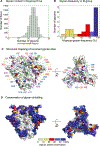Hitting the sweet spot: exploiting HIV-1 glycan shield for induction of broadly neutralizing antibodies
- PMID: 32675574
- PMCID: PMC7877895
- DOI: 10.1097/COH.0000000000000639
Hitting the sweet spot: exploiting HIV-1 glycan shield for induction of broadly neutralizing antibodies
Abstract
Purpose of review: The surface of the HIV-1 Env glycoprotein, the target of neutralizing antibodies, is extensively covered by N-linked glycans that create a glycan shield. Broadly neutralizing antibodies (bNAbs), the primary targets of HIV-1 vaccine design, have to negotiate this glycan shield. Here, we review the barriers and opportunities that the HIV-1 glycan shield presents for vaccine induction of bNAbs.
Recent findings: Glycan shields can impact the nature of the antibody response and influence the development of neutralization breadth in HIV-1 infections. The architecture of the glycan shield arising from glycan interactions and dynamics have been modeled, and its fine structure, that is, the site-wise glycan heterogeneity, has been determined for some isolates. Although the extent of glycan shielding is conserved, the precise number, location and processing of glycans, however, is strain-dependent. New insights continue to reveal how such differences can impact bNAb activity and development. Novel approaches have exploited the glycan shield for designing immunogens that bind the germline precursors of bNAbs, a critical roadblock for vaccine-induction of bNAbs.
Summary: The HIV-1 glycan shield can significantly impact the induction and maturation of bNAbs, and a better understanding of how to manipulate it will improve immunogen design.
Conflict of interest statement
Conflicts of interests
None.
Figures


References
-
-
Bricault CA, Yusim K, Seaman MS, Yoon H, Theiler J, Giorgi EE, et al. HIV-1 Neutralizing Antibody Signatures and Application to Epitope-Targeted Vaccine Design. Cell Host & Microbe 2019;25:59–72.e8. 10.1016/j.chom.2018.12.001.
* In this study, we identified a comprehensive set of sequence (amino acid, glycans and hypervariable region characteristics) signatures associated with activity of multiple bNAbs from each major bNAb-class.
-
-
-
Wagh K, Kreider EF, Li Y, Barbian HJ, Learn GH, Giorgi E, et al. Completeness of HIV-1 Envelope Glycan Shield at Transmission Determines Neutralization Breadth. Cell Reports 2018;25:893–908.e7. 10.1016/j.celrep.2018.09.087.
* In this study, we developed an approximate but accurate strategy to map glycan shields for a given Env sequence, and used this to explore the impact of glycan shield evolution on bNAb development.
-
Publication types
MeSH terms
Substances
Grants and funding
LinkOut - more resources
Full Text Sources
Medical
Research Materials

